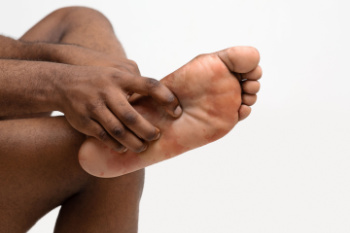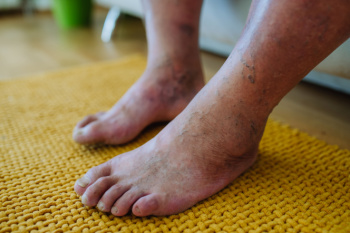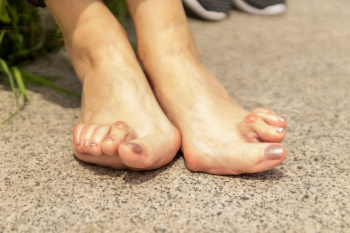Items filtered by date: March 2025
Why Your Heel Hurts in the Morning

If you wake up and feel a sharp pain in your heel when you take your first steps, you are not alone. This is one of the telltale signs of plantar fasciitis, a common cause of heel pain. But why does it hurt most in the morning? While you sleep, your foot relaxes and the plantar fascia, a thick band of tissue running along the bottom of your foot, tightens. When you stand up, the tissue stretches suddenly, causing pain. Plantar fasciitis can happen to anyone, but it is especially common if you spend a lot of time on your feet, have flat feet or high arches, or wear shoes that lack adequate support. The good news is that early treatment can make a big difference. Simple stretches, better footwear, and custom orthotics can help. If heel pain is slowing you down, it is suggested that you see a podiatrist for a proper diagnosis and appropriate treatment.
Plantar fasciitis is a common foot condition that is often caused by a strain injury. If you are experiencing heel pain or symptoms of plantar fasciitis, contact Jim Maxka, DPM from South Penn Foot & Ankle Associates. Our doctor can provide the care you need to keep you pain-free and on your feet.
What Is Plantar Fasciitis?
Plantar fasciitis is one of the most common causes of heel pain. The plantar fascia is a ligament that connects your heel to the front of your foot. When this ligament becomes inflamed, plantar fasciitis is the result. If you have plantar fasciitis you will have a stabbing pain that usually occurs with your first steps in the morning. As the day progresses and you walk around more, this pain will start to disappear, but it will return after long periods of standing or sitting.
What Causes Plantar Fasciitis?
- Excessive running
- Having high arches in your feet
- Other foot issues such as flat feet
- Pregnancy (due to the sudden weight gain)
- Being on your feet very often
There are some risk factors that may make you more likely to develop plantar fasciitis compared to others. The condition most commonly affects adults between the ages of 40 and 60. It also tends to affect people who are obese because the extra pounds result in extra stress being placed on the plantar fascia.
Prevention
- Take good care of your feet – Wear shoes that have good arch support and heel cushioning.
- Maintain a healthy weight
- If you are a runner, alternate running with other sports that won’t cause heel pain
There are a variety of treatment options available for plantar fasciitis along with the pain that accompanies it. Additionally, physical therapy is a very important component in the treatment process. It is important that you meet with your podiatrist to determine which treatment option is best for you.
If you have any questions, please feel free to contact our office located in Hanover, PA . We offer the newest diagnostic and treatment technologies for all your foot care needs.
The Importance of Diabetic Foot Care

Proper foot care is essential for individuals with diabetes to prevent complications that can lead to serious infections or ulcers. Daily foot inspection helps identify cuts, blisters, or changes in skin color before they become severe. Washing feet with mild soap and warm water keeps the skin clean and reduces the risk of infections. Protecting feet by keeping them moisturized and avoiding walking barefoot prevents injuries that may go unnoticed due to reduced sensation. Wearing well-fitted, supportive footwear helps prevent pressure points and friction that can lead to sores. Additionally, keeping toenails trimmed straight across reduces the risk of ingrown nails and infections. If you have diabetes, it is strongly suggested that you visit a podiatrist regularly who can help you to manage this serious condition.
Diabetic foot care is important in preventing foot ailments such as ulcers. If you are suffering from diabetes or have any other concerns about your feet, contact Jim Maxka, DPM from South Penn Foot & Ankle Associates. Our doctor can provide the care you need to keep you pain-free and on your feet.
Diabetic Foot Care
Diabetes affects millions of people every year. The condition can damage blood vessels in many parts of the body, especially the feet. Because of this, taking care of your feet is essential if you have diabetes, and having a podiatrist help monitor your foot health is highly recommended.
The Importance of Caring for Your Feet
- Routinely inspect your feet for bruises or sores.
- Wear socks that fit your feet comfortably.
- Wear comfortable shoes that provide adequate support.
Patients with diabetes should have their doctor monitor their blood levels, as blood sugar levels play such a huge role in diabetic care. Monitoring these levels on a regular basis is highly advised.
It is always best to inform your healthcare professional of any concerns you may have regarding your feet, especially for diabetic patients. Early treatment and routine foot examinations are keys to maintaining proper health, especially because severe complications can arise if proper treatment is not applied.
If you have any questions please feel free to contact our office located in Hanover, PA . We offer the newest diagnostic and treatment technologies for all your foot and ankle needs.
Symptoms and Testing for Foot Drop

Foot drop occurs when patients find it difficult to lift the front portion of their foot, resulting in dragging or slapping of the foot while walking. Known as steppage gait, this walking pattern involves raising the leg higher than usual to prevent the toes from catching on the ground. Foot drop may affect one or both feet, causing sensations of tingling, numbness, or weakness in the ankle, toes, or top of the foot. Several conditions can cause foot drop, including peripheral neuropathy, muscular dystrophy, nerve injury, diabetes, and neurological issues like stroke or multiple sclerosis. A podiatrist can assess symptoms through a physical examination, checking for muscle weakness or loss of function, and by performing nerve conduction studies, ultrasounds, or imaging tests to rule out other causes. Treatment of foot drop often involves nerve stimulation, or wearing braces or orthotics to support proper foot positioning. In some cases, surgery may be needed to repair nerve damage or reposition tendons. If you have trouble lifting your feet when walking, it is suggested that you schedule an appointment with a podiatrist for an exam, diagnosis, and treatment.
If you have any concerns about your feet, contact Jim Maxka, DPM from South Penn Foot & Ankle Associates. Our doctor can provide the care you need to keep you pain-free and on your feet.
Biomechanics in Podiatry
Podiatric biomechanics is a particular sector of specialty podiatry with licensed practitioners who are trained to diagnose and treat conditions affecting the foot, ankle and lower leg. Biomechanics deals with the forces that act against the body, causing an interference with the biological structures. It focuses on the movement of the ankle, the foot and the forces that interact with them.
A History of Biomechanics
- Biomechanics dates back to the BC era in Egypt where evidence of professional foot care has been recorded.
- In 1974, biomechanics gained a higher profile from the studies of Merton Root, who claimed that by changing or controlling the forces between the ankle and the foot, corrections or conditions could be implemented to gain strength and coordination in the area.
Modern technological improvements are based on past theories and therapeutic processes that provide a better understanding of podiatric concepts for biomechanics. Computers can provide accurate information about the forces and patterns of the feet and lower legs.
Understanding biomechanics of the feet can help improve and eliminate pain, stopping further stress to the foot.
If you have any questions please feel free to contact our office located in Hanover, PA . We offer the newest diagnostic and treatment technologies for all your foot and ankle needs.
Do Your Child's Feet Hurt?
How Podiatrists Can Help People With Rheumatoid Arthritis

Rheumatoid arthritis, or RA, affecting the feet can cause significant pain, stiffness, and joint damage, making daily activities challenging. Risk factors include genetics, smoking, obesity, and an inactive lifestyle, all of which can worsen RA symptoms. While there is no cure, a healthy diet rich in anti-inflammatory foods like fruits, vegetables, and omega-3 fatty acids can help reduce flare-ups and support joint health. Regular, low-impact physical activity, such as walking, swimming, or stretching, keeps joints flexible and prevents stiffness. Wearing proper footwear and orthotics also play a vital role in minimizing discomfort and supporting foot alignment. A podiatrist can provide tailored care, including custom orthotics, footwear recommendations, and strategies for managing foot pain. If you have RA that affects your feet, it is suggested that you seek routine care from a podiatrist for help in maintaining mobility, preventing deformities, and improving your overall quality of life.
Because RA affects more than just your joints, including the joints in your feet and ankles, it is important to seek early diagnosis from your podiatrist if you feel like the pain in your feet might be caused by RA. For more information, contact Jim Maxka, DPM of South Penn Foot & Ankle Associates. Our doctor will assist you with all of your podiatric concerns.
What Is Rheumatoid Arthritis?
Rheumatoid Arthritis (RA) is an autoimmune disorder in which the body’s own immune system attacks the membranes surrounding the joints. Inflammation of the lining and eventually the destruction of the joint’s cartilage and bone occur, causing severe pain and immobility.
Rheumatoid Arthritis of the Feet
Although RA usually attacks multiple bones and joints throughout the entire body, almost 90 percent of cases result in pain in the foot or ankle area.
Symptoms
- Swelling and pain in the feet
- Stiffness in the feet
- Pain on the ball or sole of feet
- Joint shift and deformation
Diagnosis
Quick diagnosis of RA in the feet is important so that the podiatrist can treat the area effectively. Your doctor will ask you about your medical history, occupation, and lifestyle to determine the origin of the condition. Rheumatoid Factor tests help to determine if someone is affected by the disease.
If you have any questions please feel free to contact our office located in Hanover, PA . We offer the newest diagnostic and treatment technologies for all your foot and ankle needs.

